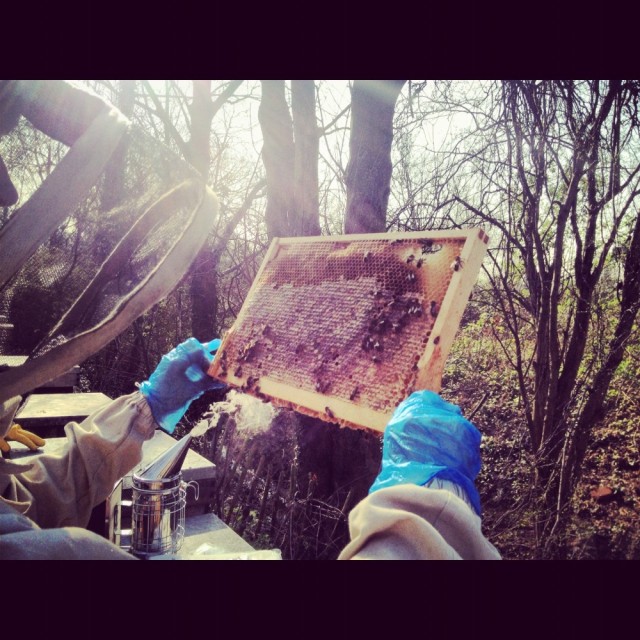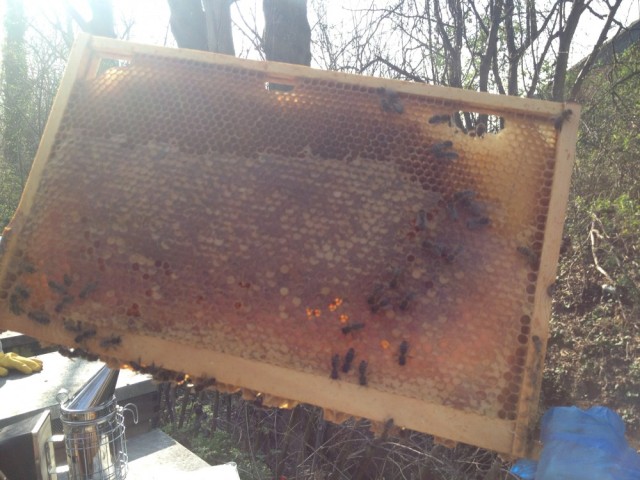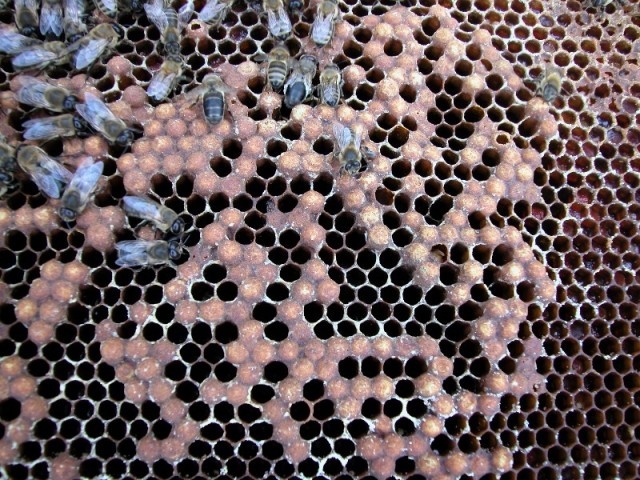After months of revising, I finally took the British Beekeeping Association’s Module 1 Honeybee Management exam on Saturday. It’s a relief to get it out of the way – I can finally start on the pile of non-beekeeping related books I haven’t been able to read! The revising has been mostly fun really though, I like learning new things about bees.
The questions weren’t too bad…not too many hive dimensions needed…for the four section B 12 minute questions, I answered ways of clipping & marking a queen, how to make up a five frame nucleus, one way of carrying out swarm control and how to identify queenlessness, a drone laying queen and laying workers in a hive.
For the longer 30 minute section C question, which you get the most marks for, I chose the question on how to advise someone on beginning beekeeping – much easier than the alternative question on preparing bees to take them to heather! That’s a question for the northern beeks.
Home for lunch, then off out to proper beekeeping. It was a beautiful day – 22°C in London! – so a perfect opportunity to inspect our hives for the first time since October.
First, Rosemary:
These photos of Emma holding up honey stores may look pretty idyllic, but all was not quite right within Rosemary’s hive. Plenty of adult bees, but also lots dead on the floor. And most worrying, small amounts of brood – less than 3 frames worth – and drone cells in the middle and top of the comb, which is a sign of a failing queen. Usually drone cells would be found towards the bottom of the comb. Only a few eggs could be seen, and it took several goes by different people before Pat was finally able to spot them.
John Chapple brought a frame from another hive over to us. “What can you see here?” he asked. The frame contained lots of drone brood in the centre too. “Yes”, John said, “but look at the bees – what are they?”. They looked like workers in size, but John revealed they were drones, given away only by their bulbous eyes, much bigger than those of workers. The drones were stunted as the result of having been laid in worker cells. They are doomed, unable to reproduce, only able to eat stores. Unless it is requeened, a hive which has a drone laying queen or laying workers can only get weaker and weaker.
Below is a photo from the government’s Beebase website showing domed drone brood in worker cells. Some of those worker size bees have very beady eyes and I believe may actually be stunted drones. The difference is subtle. You can also clearly see a dark drone with damaged wings as a result of deformed wing virus towards the top centre of the photo.
Here’s what Ted Hooper has to say about drone laying queens in his Guide to Bees and Honey, p182:
“The drone laying queen is usually quite obvious when she first starts to produce drone brood in worker cells because these will be mixed in with worker brood. As time proceeds the amount of worker cappings reduces and the number of drone cappings increases. Whilst there are worker cappings left it is obviously a queen laying, and not workers, but as the queen gets progressively shorter of sperm so the time will come when nothing but drone cappings is present. The colony will still be reasonably large – with at least two or three combs of brood – and normally the beekeeper who regularly examines his colonies will see what is happening and will have solved the problem by requeening.”
We saw Rosemary, and we saw a small amount of worker brood, so that appears to be what is happening here. There won’t be many spare queen cells around the apiary in March, but I guess we could order in a queen. Rosemary has been a great queen though, and it would be a shame to lose her ultra-calming genes. We could hope the bees produce a supersedure cell from the few remaining worker eggs now that the weather has improved, or we could put Rosemary out of her misery and combine the workers with Lavender’s hive (Lavender is Rosemary’s sister). Emma and I will have to talk it through and reach a decision.
Incidentally, it is a little odd that she seems to have become a drone layer. She’s less than a year old and there are hundreds of hives producing drones for her to mate with in Ealing, so she shouldn’t be poorly mated or getting old and running out of sperm. Chris Slade has an interesting blog post at http://chrissladesbeeblog.wordpress.com/2012/03/25/darg/ – he says that there is research going on in Devon with regard to the increasing incidence of drone laying queens. Certainly lots of people seem to be having this problem at the moment, and the bee inspectors say commercial US beekeepers have taken to requeening every six months! Wonder if the problem is associated with varroa as is so often the case.
Emma and I changed our minds at the last minute about doing a shook-swarm, as an experiment we’re trying out the Bailey comb exchange method instead this year. The first step is to put a brood box of clean foundation on top of the old brood box. You funnel the bees up by putting dummy boards on the edge of the brood nest in both boxes, which helps keep conditions warm to aid wax drawing, and feed with a 2:1 strength sugar syrup through the crown board. The idea is the bees draw out new combs from the foundation and once that happens you can move the queen up, put a queen excluder between the two boxes and destroy the old combs below once the brood has hatched out. I’ll let you know how it goes.
Emma has done a great blog post with more photos from the day, including Queen Rosemary, the stunted drones John showed us, and more info on the Bailey exchange: http://missapismellifera.com/2012/03/30/bailey-comb-change-for-spring-bees.




My method of doing the Bailey change is to use 2 sheets of foundation. One is kept complete and is placed in the centre of the brood box. The other is cut into starter strips for the remaining frames. Place the brood box above the existing one,and below QE and super. The bees will move up and start drawing comb almost immediately and the queen be laying within days. When she’s there, put a second QE beneath her. Wait 3 weeks and remove the lower box. There may be a little drone brood that you could choose to sacrifice for Varroa control or not depending on circumatances. All feeding is done by the farmer or nature.
That FERA photo has several cells in which I would dip a match stick to check for AFB!
LikeLike
Thanks Chris, it is interesting how many variations there are on the Bailey.
LikeLike
Ah, it was so lovely to see our bees again and pleased our July queen, Lavender, is doing so well – after a small detour on my thumb! But poor Rosemary, I did wonder if there were stunted drones in that hive too. Perhaps our bees will sense she is failing and make a new queen like they did with Rose last year. It would be nice to rear our own queen again – we could add a frame of eggs or young larvae from Lavender’s hive to Rosemary’s if it is strong enough in a couple of weeks? So, it just got interesting… again… 🙂
LikeLike
I am hoping the bees try to make a new queen. If not, that is a good idea about taking a frame from Lavender’s hive…
LikeLike
I’m sure you aced the test! But not so good news about the drone laying queen. Funny how that can happen all of a sudden, because you had no indication last season that anything was up, right? I think think the most recent BBKA newsletter mentions it briefly. Did she mate late in the season?
LikeLike
Thanks! Looking back at my notes, she mated in late July. So fairly late in the season but I remember there still being plenty of drones about at the time. This was our first time inspecting since the winter so it’s possible she’s been going that way for a while without us noticing.
LikeLike
I’m excited for your test results. When do you find out? Oh, and that first picture was fantastic. Such rich texture.
I’ve been meaning to rotate the wax in my hives, but I’ll probably wait until next year. My surviving hive is only a year old at this point, and I see little point in pulling the wax now.
LikeLike
Don’t be excited, I might well have failed! I’m trying not to get my hopes up too much. If your combs are only a year old then you can probably wait a year or two.
LikeLike
I had laying workers last summer – I can appreciate your frustration. I am impressed with the exams your are required to take in order to keep bees. We have no such requirement here in the US, and I hope we never do; we need backyard bee keepers, and I think it would deter people from taking up the hobby. However, that being said, I think there is a significant benefit to the exams and the course of study necessary to successfully complete them. Best of luck to you. I have enjoyed following your progress and have learned from you!
LikeLike
I didn’t mean to give people the idea that you have to take these exams to keep bees here…that’s not at all the case, anyone can keep them. I’m just taking the exams for fun (mad, I know!).
LikeLike
Exams for fun?? For me, that would be like watching paint dry!! 🙂 🙂 Can’t wait to hear the results.
LikeLike
Weird, I know. I guess I like the challenge, it forces me to learn stuff. It’s probably the same reason people enter marathons, it gives you something to aim for, only I can do my training indoors in the warm!
LikeLike
Pingback: Bailey comb change for spring bees | Miss Apis Mellifera
Blimey. It’s a real eye-opener reading your blog. I never realised how complicated bee-keeping is. Good luck with your failing queen. If I took an exam which had a question about drones, I would assume that it referred to ‘The Drones Club’ from the writings of P.G.Wodehouse. (Good light reading btw now that you’re taking a break from the textbooks!)
LikeLike
It is complicated, especially if you try to do it well! I shall check out the book recommendation for my fun books pile 🙂
LikeLike